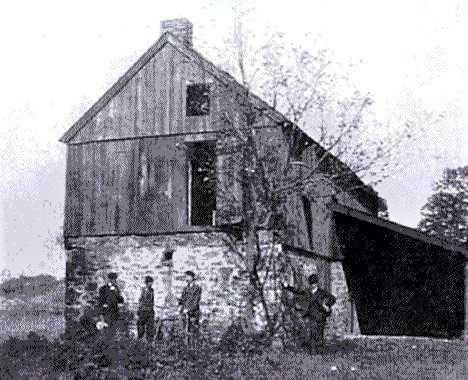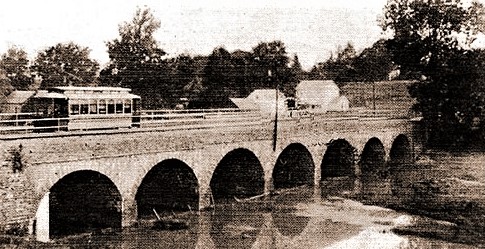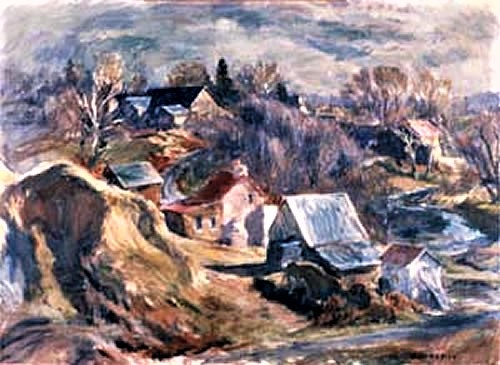A remembrance of Philly’s “Scumblers” and their “Shack” on Neshaminy Creek.
Most of us are aware the Pennsylvania Art Impressionist movement was born in New Hope in 1900 and made Bucks County internationally famous. Having written earlier about the movement, I heard from reader Donna Fisher. “Ever hear of the Scumblers?” she asked. What’s a Scumbler? Are they like me when I was a youth and hired on to clean pots and pans at carnivals passing through Merced?

Not quite, laughed Donna. The Scumblers were rivals to the New Hope art colony. In their time they painted a legacy of their own in the village of Edison a couple miles below Doylestown. They were a dozen Philadelphia commercial artists who summered in Edison between 1900 and 1920. The group set up shop in an old barn where they socialized and practiced their art.
Donna mentioned the barn still exists. I decided to take a look. Unless you exit 4-lane Route 611 at the small road sign for Edison, you’ll miss the tiny village sandwiched by the steady hum of heavy industry, commerce and traffic. Years ago the highway was routed around town to preserve its narrow, two-block strip of Early American architecture. Back then it was called Bridge Point for an iron bridge over the Neshaminy and the village’s unusual thumb of hilly terrain enwrapped on three sides by the stream.
About 40 years after its founding in 1764, the settlement morphed into a prominent manufacturing and education center on the arrival of Dr. Samuel Moore from New Jersey. He revived two old grist and oil mills, built a woolen factory and saw mill, established a few shops, and constructed a two-story private school near his mansion on a prominence overlooking town. Moore later served in Congress and was appointed director of the U.S. Mint in Philadelphia.

To better serve the village, a seven-arch stone bridge replaced the iron bridge in 1821. It later carried the Willow Grove-to-Doylestown trolley line. When a post office opened in 1880, the town became Edison in honor of Thomas Edison who just had invented the light bulb. The village, the bridge, easy access by trolley and the surrounding rural landscape began to attract artists.
Setting out the welcome mat was George Willman who bought the closed Edison schoolhouse and converted it into an art studio. The Scumblers, meanwhile, had established a long tradition of meeting every Thursday night in Philadelphia. During the city’s oppressive summertime heat, the group preferred vacationing in the countryside. In 1900, they discovered Edison and its art studio, an easy two-hour excursion by trolley. It was a time when New Hope’s art colony was taking off at Phillip’s Mill 12 miles to the north. In Edison, the Scumblers and their families booked stays at The Turk’s Head Tavern, a large Revolutionary War-era inn near the village. Others arranged room rentals at local homes.
The leader of the Scumblers was Clive Clevenger who took possession of an abandoned wooden barn with a stone ground floor on the banks of the Neshaminy near the bridge. It provided a cozy meeting place in a large room with a stone fireplace. “Uncle Clive” was the landlord of “The Shack”, today’s centerpiece of Edison’s Bridge Point Park. In my visit, I was unable to find any reference to the Scumblers though a history of the remodeled building as a place to repair wagon wheels is prominently displayed. The stone bridge is long gone. Its abutment still exists with iron rails of the former trolley mired in asphalt and curving to an abrupt end against the stone rampart.

The Scumblers were noteworthy in Philadelphia but did not achieve the recognition of the New Hope impressionists who lived and practiced their art year-round in Bucks. The Edison artists specialized in landscape oils and watercolors. Prominent among them were William A. Hofstetter (“master of sunlight and shadow”), Ellis Augustus Oliver, Louis R. Dougherty, Winfield Scott Bardsley and Clevenger.
What about that name – Scumblers? I dropped by the home of renowned artist Robert Seufert in Fairless Hills for an explanation. “I haven’t heard that term in 30 years! It’s a process,” he exclaimed with a wide grin. He led me into the family’s large classroom studio where his talented son Patrick engaged a half-dozen students. Father and son agreed “scumbling” was an art term for using stiff bristles to wash color over lower layers of pigment on a canvas. The process gives the painting texture while allowing underlaying color to bleed through. Bob found a scumble brush to demonstrate the method over an online still of a scumble painting.
Aha! So that’s what distinguishes the works of Edison’s Scumblers. Pot scrubbing ala Merced has nothing to do with it.
Sources include “The Villages of Bucks County: A Guidebook” compiled by the Bucks County Planning Commission in 1987; “The Scrumblers and their Shack at Edison in Bucks County, Pennsylvania” by Richard Oliver OSB and Chuck Rudy found on the web at
http://richoliver.us/eao/scumblers/ Brother Oliver, a St. Benedictine monk based at St. John’s Abbey in Collegeville, Minn. is the grandson of Ellis Augustus Oliver, one of the Scumblers.

